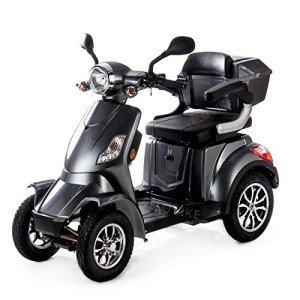The Most Pervasive Issues With Buying Mobility Scooter

A Comprehensive Guide to Buying a Mobility Scooter
Mobility scooters have actually become an essential tool for lots of people seeking to boost their self-reliance and mobility. With a vast range of designs and functions offered, picking the ideal mobility scooter can be intimidating. This short article offers a useful guide to help customers navigate their alternatives, examine their needs, and make a notified purchase.
Understanding Mobility Scooters
Mobility scooters are electric automobiles created for individuals who experience mobility difficulties. see post are particularly useful for seniors, those with impairments, or individuals recovering from injuries. Mobility scooters can vary widely in regards to style, features, and pricing.
Types of Mobility Scooters
Before embarking on a purchase, it's necessary to understand the various types of mobility scooters offered:
Three-Wheel Scooters:
- Generally more maneuverable in tight areas
- Lightweight and portable
- Suitable for indoor use
Four-Wheel Scooters:
- Offer higher stability and balance
- Appropriate for outdoor use over various terrains
- Typically have a longer battery life
Foldable/Portable Scooters:
- Designed to be easily transported and kept
- Can typically suit the trunk of a cars and truck
- Ideal for those who take a trip regularly
Heavy-Duty Scooters:
- Built to accommodate larger individuals
- Typically included more robust functions for outdoor use
- Usually equipped with larger batteries for prolonged range
Elements to Consider When Buying a Mobility Scooter
1. Weight Capacity
Choose a mobility scooter that can support the user's weight. Most scooters have a weight limit varying from 250 to 500 pounds. It is vital to ensure that the scooter can accommodate the user conveniently.
2. Range and Battery Life
The variety is how far the mobility scooter can take a trip on a single charge. Typical varieties vary between 10 to 30 miles. Think about the user's day-to-day activities and choose a scooter with an appropriate range.
3. Scooter Dimensions
Consider the size of the scooter, including its weight and measurements. A more compact scooter may be ideal for narrow corridors and tight areas, while bigger designs use extra stability and convenience.
4. Surface Capability
Examine where the scooter will mostly be used. If the user prepares to take a trip mostly on pavement, a lightweight model may be enough. Nevertheless, if the user requires to pass through gravel or irregular surfaces, think about a four-wheel scooter developed for off-road use.
Leading Features to Look For
Convenience
- Adjustable Seats: Look for scooters with cushioned and height-adjustable seats to guarantee comfort during travel.
- Armrests: These enhance safety and support while browsing.
Security and Visibility
- Headlights and Taillights: Essential for nighttime usage.
- Turn Signals and Reflectors: Improve exposure and security while on the road.
User-Friendly Controls
- Joystick or Drive Controls: These must be intuitive and simple to control.
- Easy-to-Read Displays: A control board that shows battery life, speed, and range can boost the user experience.
Extra Features
- Storage Compartments: These provide added convenience for carrying individual products while on the go.
- Weather Protection: Consider models with rain covers or windshields if utilized in variable weather conditions.
Expense Considerations
When budgeting for a mobility scooter, costs can range anywhere from ₤ 500 to over ₤ 5,000 depending on the design, features, and brand. Additional costs may include:
- Extended Warranty: Protects versus flaws and can conserve money in the long run.
- Devices: Optional functions, such as upgraded seats, lights, or storage solutions.
| Feature | Expense Range |
|---|---|
| Standard Models | ₤ 500 - ₤ 1,500 |
| Mid-Range Models | ₤ 1,500 - ₤ 3,000 |
| High-End Models | ₤ 3,000 - ₤ 5,000 |
Financing Options
Lots of retailers provide funding plans, and some city government efforts may supply grants or assistance for those in need. Investigate prospective financial help with community resources or mobility service organizations.
Frequently asked questions about Buying a Mobility Scooter
What is the distinction between a mobility scooter and a wheelchair?
Mobility scooters are motorized and permit users to browse individually, while wheelchairs may need physical assistance or manual operation.
How do I maintain a mobility scooter?
Routine maintenance includes examining battery life, cleaning up the scooter, and inspecting tires and brakes. Constantly describe the user handbook for specific standards.
Can mobility scooters be used inside?
Yes, numerous models are created for both indoor and outside usage. Nevertheless, three-wheel scooters tend to be much better matched for indoor navigation due to their tighter turning radius.
Are mobility scooters covered by insurance?
Some insurance prepares cover a portion of the expenses for mobility scooters if they are considered clinically essential. Contact your provider for particular information.
How quickly can a mobility scooter go?
Most mobility scooters have an optimal speed varying from 4 to 8 mph. Nevertheless, the proper rate may differ depending on local guidelines.
Acquiring a mobility scooter can considerably enhance one's independence and quality of life. By comprehending the types, functions, and expenses associated with mobility scooters, potential purchasers can make educated choices that match their needs and preferences. Customization and thorough research study are key to guaranteeing complete satisfaction with this crucial financial investment.

